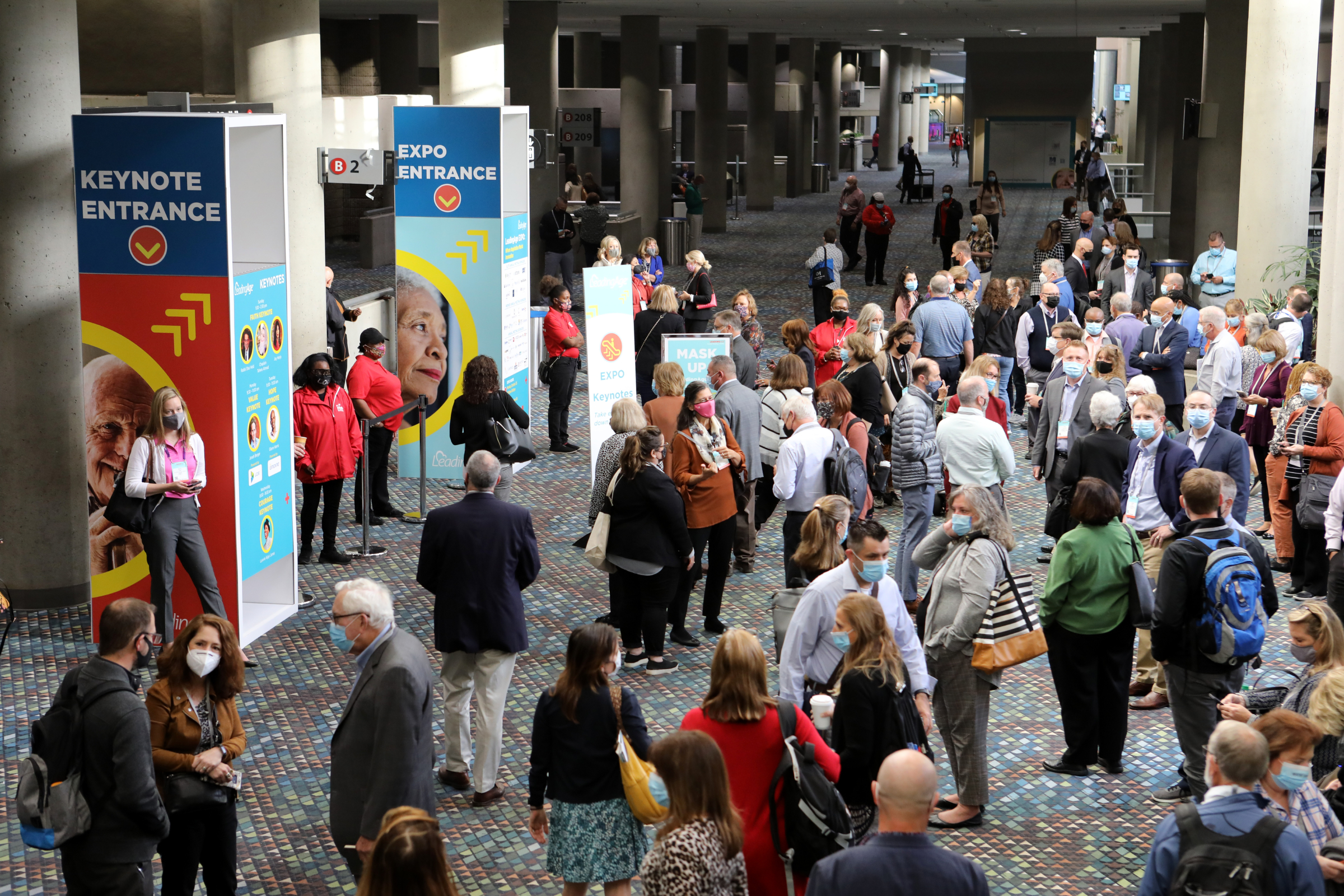Hospice FY2023 Wage Index Rule Summary
Hospice FY2023 Wage Index Rule Summary
March 31st, 2022
The proposed FY2023 Hospice Wage Index and Payment Rate Update and Hospice Quality Reporting Requirements was released on the Federal Register public inspection site on March 30th and is scheduled for publication in the Federal Register on April 4th. This summary is not exhaustive; we encourage members to read the whole rule. The page numbers referenced in this summary refer to the public inspection copy of the rule linked here.
LeadingAge will convene members in at the April 12th meeting of the Hospice Member Network to discuss the rule and formulate comments. Join the Network here or emailing Katy Barnett.
Proposed Permanent Cap on Hospice Wage Index Decreases (PGS. 20-25)
The proposed FY2023 hospice wage index would include a permanent 5-percent cap on wage index decreases. This change was initially made in FY2021 final rule to mitigate the impact of Hospital Wage Index calculations issued by the Office of Management and Budget. By making this change permanent CMS believes this will provide greater transparency and be administratively less complex as well as giving providers time to adjust to new yearly labor market delineations and wage index values.
In previous years, CMS received comments raising concerns about significant changes to labor markets areas and the impact this could have on Medicare payments. In the past, CMS implemented limited term, phased transition policies when significant changes to the labor market areas occurred in an attempt to mitigate short term instability and fluctuations. CMS recognizes that external factors, outside of the provider’s control, like the COVID-19 Public Health Emergency (PHE), can impact labor market area changes making predictability of Medicare payments difficult to budget and plan for in operations.
CMS further proposed this new 5-percent cap would be applied after the hospice wage index floor, meaning values below 0.8 would be adjusted by the 15 percent wage floor increase and if the resulting wage index was a 5 percent decrease from the previous FY’s wage index value after the floor, then a 5-percent cap on wage index decreases would also be applied.
CMS provided an estimate of the impact to payments for providers in FY2023 based on this policy change on page 65 of the rule and stated they would examine the proposed policy’s effects on an ongoing basis.
Proposed FY2023 Hospice Payment Rates (PGS. 25-32)
Taking into account the proposed changes for the hospice wage index, the FY2023 proposed payment rates are increased by 2.7 percent (please see the rule for the SIA budget neutrality factor, the wage index standardization factor, and labor share standardization factor). These rates are for hospices that submit their required quality data.
|
Code |
Description |
FY 2022 Payment Rate |
Proposed FY 2023 Hospice Payment Update |
Proposed FY 2023 Payment Rates |
|
651 |
Routine Home Care (days 1-60) |
$203.40 |
x1.027 |
$209.14 |
|
651 |
Routine Home Care (day 61+) |
$160.74 |
x1.027 |
$165.25 |
|
652 |
CHC Full Rate = 24 hours of care |
$1,462.52 ($60.94 per hour) |
x1.027 |
$1,505.61 |
|
655 |
IRC |
$473.75 |
x1.027 |
$486.88 |
|
656 |
GIP |
$1,068.28 |
x1.027 |
$1,098.88 |
The proposed hospice cap for FY2023 cap year is $32,142.65, which is equal to the FY 2022 cap amount ($31,297.61) updated by the proposed FY 2023 hospice payment update percentage of 2.7 percent. Additionally, the Consolidated Appropriations Act, 2021 extends the provision that currently mandates the hospice cap be updated by the hospice payment update percentage rather than the CPI-U from ending on October 1, 2025, to now ending on October 1, 2030.
The proposed hospice wage index application for FY 2023 (October 1, 2022 through September 30, 2023) is available on CMS’ website at: www.cms.gov/Medicare/Medicare-Fee-for-Service-Payment/Hospice/Hospice-Wage-Index.html
Updates to the Hospice Quality Reporting Program (PGS. 32-49)
Quality Reporting Penalty Update
The Consolidated Appropriations Act, 2021 increased the payment reduction for hospices who fail to meet hospice quality measure reporting requirements from 2% to 4% beginning in FY 2024 annual payment update (APU) based on CY 2022 quality data. This aligns with all other setting reporting requirement penalties.
HOPE Tool Beta Testing
Alpha testing of the HOPE tool ended in January 2021 and showed general feasibility of collecting items as well as acceptable inter-rater reliability. National beta testing of the tool started in fall 2021 and will continue through 2022. The final beta and field-testing results will be used to create the final version of the HOPE tool to propose in future rulemaking for national implementation. CMS will continue to host HQRP Forums to allow hospices and other interested stakeholders to engage on the latest updates and to ask questions on the development of HOPE and related quality measures. CMS has also created a dedicated email account for comments about HOPE: HospiceAssessment@cms.hhs.gov.
Update on Future Quality Measure Development
CMS is looking for input on hospice quality measure concepts based on future use of HOPE and administrative data. More specifically, CMS is seeking public comment on hospice health equity initiatives and structural composite measure concept to inform future measure development. See below for more information.
Hospice CAHPS Web-based Survey
Recently, CMS conducted a mode experiment aimed at assessing the effects of adding a web-based mode to the CAHPS Hospice Survey. The survey currently has three modes, phone, mail, and mail with telephone follow up. CMS is examining the results of the web-based mode on survey response rates and scores but will also examine:
- effects of shortened survey on response rate and scores
- supplemental survey items suggested by stakeholders
- calculation of item-level mode adjustments for the shortened survey in the current modes and proposed web-based mode
Request for More Information on Health Equity (PGS. 49-56)
Based on the feedback received from the FY2022 Hospice Wage Index proposed rule request for information on health equity, CMS is asking for public comment on specific work hospices have conducted around health equity using the following questions:
- What efforts does your hospice employ to recruit staff, volunteers, and board members from diverse populations to represent and serve underserved populations? How does your hospice attempt to bridge any cultural gaps between your personnel and beneficiaries/clients? How does your hospice measure whether this has an impact on health equity?
- How does your hospice currently identify barriers to access in your community or service area? What are barriers to collecting data related to disparities, social determinants of health, and equity? What steps does your hospice take to address these barriers?
- How does your hospice collect self-reported data such as race/ethnicity, veteran status, socioeconomic status, housing, food security, access to interpreter services, caregiving status, and marital status used to inform its health equity initiatives?
- How is your hospice using qualitative data collection and analysis methods to measure the impact of its health equity initiatives?
Additionally, CMS is considering a structural composite measure based on information already collected by hospices. The structural composite measure could include organizational activities to address access to and quality of hospice care for underserved populations or hospice reported data on activities to address underserved populations’ access to hospice care. CMS is interested in developing health equity measures based on information collected by hospices that is not currently available on claims, assessments, or other publicly available data.
For example, a hospice could receive a point for each domain where data are submitted to a CMS portal, regardless of the action (such as training in culturally and linguistically appropriate services, health equity, and implicit bias). The data could reflect the hospice’s completed actions for each corresponding domain (for a total of three points) in a reporting year. A hospice could also submit documentation, examples, or narratives to qualify for the measure numerator. CMS is also seeking comment on how to score a domain for a hospice that submitted data reflecting no actions or partial actions in a given domain.
CMS is interested in public comments on publicly reporting a composite structural health equity quality measure, displaying descriptive information on Care Compare from the data hospices proved to support health equity measures, and the impact of the domains and quality measure concepts on organizational culture change. CMS is seeking comment on each of the domains being considered below, including specific suggestions on items that should be added, removed, or revised.
Domain 1: Hospice commitment to reducing disparities is strengthened when equity is a key organizational priority. Candidate domain 1 could be satisfied when a hospice submits data on their actions regarding the role of health equity and community engagement in their strategic plan. Hospices could self-report data in the reporting year about their actions in each of the following areas, and submission of data for all elements could be required to qualify for the measure numerator.
- Hospice attests whether its strategic plan includes approaches to address health equity in the reporting year.
- Hospice reports community engagement and key stakeholder activities in the reporting year.
- Hospice reports on any attempts to measure input from patients and caregivers about care disparities they may experience and recommendations or suggestions.
Domain 2: Training board members, leaders, staff and volunteers in culturally and linguistically appropriate services (CLAS), health equity, and implicit bias is an important step hospices can take to provide quality care to diverse populations. Candidate domain 2 could focus on hospices’ diversity, equity, inclusion, and CLAS training for board members, employed staff, and volunteers by capturing the following self-reported actions in the reporting year. Submission of relevant data for all elements could be required to qualify for the measure numerator.
- Hospice attests whether employed staff were trained in CLAS and culturally sensitive care mindful of social determinants of health (SDOH) in the reporting year. Example data include specific training programs or training requirements for staff.
- Hospice attests whether it provided resources to staff and volunteers about health equity, SDOH, and equity initiatives in the reporting year. Examples include the materials provided, webinars, or learning opportunities.
Domain 3: Leaders and staff could improve their capacity to address disparities by demonstrating routine and thorough attention to equity and setting an organizational culture of equity. This candidate domain could capture activities related to organizational inclusion initiatives and capacity to promote health equity. Examples of equity-focused factors include proficiency in languages other than English, experience working with populations in the service area, experience working on health equity issues, and experience working with individuals with disabilities. Submission of relevant data for all elements could be required to qualify for the measure numerator.
- Hospice attests whether equity-focused factors were included in the hiring of hospice senior leadership, including chief executives and board of trustees, in the previous reporting year.
- Hospice attests whether equity-focused factors were included in the hiring of hospice senior leadership, including chief executives and board of trustees, is more reflective of the service area patient than in the previous reporting year.
- Hospice attests whether equity-focused factors were included in the hiring of direct patient care staff (for example, RNs, medical social workers, aides, volunteers, chaplains, or therapists) in the previous reporting year.
- Hospice attests whether equity focused factors were included in the hiring of indirect care or support staff (for example. administrative, clerical, or human resources) in the previous reporting year.
Update on Advancing Health Information Exchange (PGS. 56-58)
The proposed rule provides an update on a number of Department of Health and Human Services (HHS) efforts to adopt interoperable health information technology for post-acute care settings. In January, the Office of National Coordinator for Health Information Technology (ONC) released the Trusted Exchange Framework and Common Agreement Version 1 which will advance principles for health information exchange and allow for connections at different levels and is inclusive of many types of entities including post-acute care. For more information visit: www.healthit.gov/topic/interoperability/trusted-exchange-framework-and-common-agreement-tefca
Update Hospice Survey and Enforcement Procedures (PGS. 58-60)
As outlined in the CY2022 Home Health Prospective Payment System final rule, CMS stated that it would take into account comments received and work on a revised proposal to further develop the methodology for the Special Focus Program (SFP) for poor-performing hospice programs including seeking additional collaboration with stakeholders. CMS decided to initiate a hospice Technical Expert Panel (TEP) in CY2022. Accordingly, CMS plans to use the TEP findings to further develop a proposal on the methodology for establishing the hospice SFP and plans to include a proposal implementing a SFP in the FY2024 Hospice rulemaking proposed rule.

Most Recommended
October 15, 2025
 Shutdown Week Three: Impact of Ongoing Closure on Affordable Housing
Shutdown Week Three: Impact of Ongoing Closure on Affordable Housing
December 10, 2025
Fiscal Year (FY) Funding 2026
October 07, 2025
Immigrant Workforce Matching Program Brings Workforce Relief
Recently Added
December 29, 2025
 RHT Program Awards: All 50 States To Receive Funds, Says CMS
RHT Program Awards: All 50 States To Receive Funds, Says CMS
December 29, 2025
 CMS Publishes Draft OASIS-E2 Guidance Manual
CMS Publishes Draft OASIS-E2 Guidance Manual
December 23, 2025
 CMS Debuts Models: ACCESS, ELEVATE and LEAD
CMS Debuts Models: ACCESS, ELEVATE and LEAD
December 22, 2025



